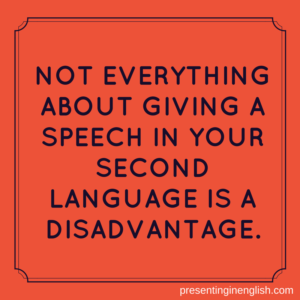
There is no denying that giving a speech in your second language is more difficult that giving one in your first language.
What follows are my reflections on how the experiences are different. These are taken from my experience giving presentations in my second language, French, as well as my experience mentoring non-native speakers giving speeches in English. I’d love to hear about your experiences, so feel free to leave a comment below.
Time
Both the time for preparation and the delivery giving a speech in your second language takes longer.
During the preparation of a speech in French, I am often still ‘thinking in English’. This creates some difficulty because sometimes my ideas and phrases can’t be directly translated into French and I have to take time to find a French way of expressing the same idea. This means research or getting a native speaker to look at my text. Similarly, when practising my presentation it takes double the amount of practice time to get it to the same level as my English presentations. This may be more or less for you depending on your level of fluency.
My speaking rate is also slower in French, because I have to think more. I also have more pauses because I am searching for words and I use more filler words. So it is important to time yourself to make sure you are not speaking longer than your set time limit.
Searching for the correct words during a presentation will not only slow you down, but also can put more pressure on you, which brings me to my next thought.
Nerves
You may feel more nervous presenting in your second language. This can be for a variety of reasons. For instance, being nervous that you may make grammar mistakes or that the audience won’t understand your accent.
Unfortunately, your nervousness will probably never go away entirely, but you can combat your nerves by being well prepared. If you take that extra time to prepare for a presentation in your second language you can be confident that you have done everything you could to give the best presentation possible. For other tips to combat nervousness, see this great article on the Eloquent Woman blog.
However, not everything about giving a speech in your second language is a disadvantage. In fact, there are even a couple of advantages!
Focus and Clarity
As discussed above it will take you longer to prepare a presentation in your second language, but this will ensure that you get straight to the point in your presentation. You won’t be tempted to add non-essential information to your presentation, because that will mean a lot more work for you. You will also probably keep your presentation shorter.
A second advantage is that since your vocabulary in your second language is smaller, you will be more likely to use simple words that are easy to understand. This is not a disadvantage. Using clear language will make it easier for your audience to understand your key message. You won’t add in extra adjectives to make it sound nice or long complicated sentences that are hard to follow. Being clear with your words and with your message will offset any misunderstandings due to pronunciation and grammar mistakes.
Stay tuned for a post later this week of my three top tips to succeed in a presentation in your second language!
